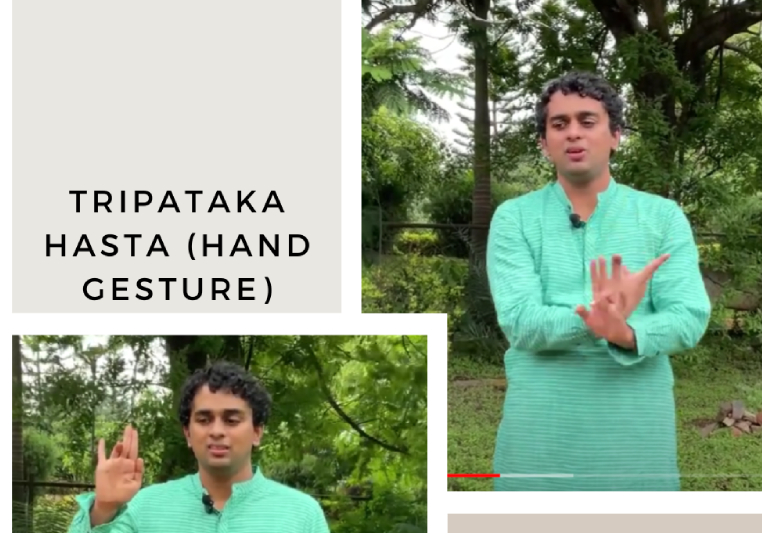An exciting moment in my journey!
My first hasta (hand gesture video) for RASA web channel was released today. Watch my presentation on the Patāka hasta used to narrate the story of Hanuman and the Sanjivini herb here:
Hastas and Storytelling
Hastas or hand gestures are an important part of Indian natya. While I have learned hastas for many years, I am now discovering fun ways to use these hastas in storytelling and communication.
In natya, we have four forms of abhinaya.
- Body language (Angika abhinaya)
- Speech (Vacika abhinaya)
- Attire and Props (Aharya abhinaya)
- Emotional expression (Satvika abhinaya)
Hastas or hand gestures are an important component of angika abhinaya. Hand gestures are used to communicate a variety of ideas. There are 28 single hand gestures, and 24 double hand gestures in Abhinaya Darpana. I have to learn slokas, meanings, and gestures for these 52 hastas for my diploma in Bharatanatyam exam.
Life is Theater
The process of creating and sharing videos involves many people. We can clarify the process by describing the roles of different people. Each person has to perform their role effectively for producing the video.
Name | Role |
Ambika akka | – Define the concept |
Kameshwar mama and Poorna akka | – Write the story – Send the script |
Ananth | – Memorize Sloka that describes the viniyogas or uses of the hasta or hand gesture. Memorization includes the words, their meanings, and the hand gestures – Memorize the story – Present the sloka and story |
Rama amma | – Modify the script as needed – Check the equipment – Record and edit the video – Edit the video on Clipchamp – Upload the file to Dropbox |
Poorna akka | – Edit the video |
RASA Web channel | – Produce the video – Post the video to the RASA web channel |
100 Days of Fun with Hastas
Behind the scenes, I am doing a 100- Days of Hastas project. Artists can use 100-Day projects to organize their practice and community interactions. I will be creating and sharing videos every week during this 100-Day project.
Combining Disciplined Practice and Fun
We need consistent and systematic practice daily to learn an art form well. Since hastas can be used to convey ideas, we can also have fun using these hastas in different ways. So I am doing a 100 Days of Fun Hasta project to learn the hastas while exploring them for fun.
Last week, I practiced the Patāka hasta. I memorized the sloka and story. We recorded the video and sent it on time. The video was produced and shared on Saturday as planned.
Last week, I also learned to use a wireless microphone for recording the video. Dr. Poorna recommended a clip-on microphone. My mother and I tested the microphone. We had also purchased a new computer. So we had to spend some time testing the equipment. The audio was clearer and louder than when I don’t use a microphone.
Parent Note
Parents of Neurodivergent (ND) children are faced with overwhelming amounts of information on therapies, educational approaches etc. I developed 100-Day projects as a way to encourage parents to decide on small steps and implement them in a systematic and consistent way.
I am encouraging Ananth to organize learning as 100-Day projects. 100-Day projects are also useful for organizing sharing in communities, Thus, as part of the 100-Day project, Ananth will be regularly documenting his explorations and progress. The videos for all the 52 hastas will not be produced in this 100-Day period. We will start another 100-Day project after this one is complete.
Acknowledgements
We are very grateful to Dr. Ambika Kameshwar and Dr. Vaishnavi Poorna for expanding Ananth’s dance learning to theater explorations. Theater Arts for Holistic Development (TAHD) enables us to address a variety of learning outcomes with enjoyable activities,
